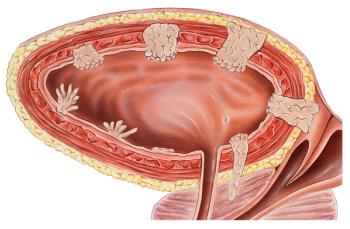
Locoregional Recurrence Rates Vary Based on Several Factors in Bladder Cancer
A meta-analysis identified several factors that are correlated with locoregional recurrence in patients with nonmetastatic muscle-invasive bladder cancer.
A meta-analysis identified several factors-including pathologic stage, pathologic lymph node stage, margin status after surgery, extent of pelvic lymph node dissection (PLND), and the number of lymph nodes removed and/or invaded-that are correlated with locoregional recurrence (LRR) in patients with nonmetastatic muscle-invasive bladder cancer (MIBC).
“LRR remains a common event in bladder cancer patients that is associated with the development of distant metastases,” wrote study authors led by Paul Sargos, MD, of the Institut Bergonié in France. “The need for an efficient strategy targeting LRR is … the starting point for treatment. Clear factors that stratify patients into different prognostic groups are needed for selection of adjuvant therapy and comparison of treatment outcomes among different institutions.”
The authors conducted a review and meta-analysis of 32 studies involving LRR and bladder cancer. The studies were published between 1980 and 2015, and all included more than 150 patients in their cohorts. The results of the analysis were
The reported rate of LRR varied widely, occurring in up to 43% of cases in a given study cohort. Eighteen of the studies evaluated the association between pathologic tumor (pT) stage and LRR, and all found a close correlation between the two. In all these studies, the LRR rate was 10% overall, but in those with pT3 or pT4 tumors the rates increased to 26.6% and 33.3%, respectively. “Further, pT stage influences greatly on LRR regardless of node involvement and surgical margins, as seen in several studies,” the authors wrote.
The impact of lymph node invasion was also consistent across studies. In general, lymph node–positive patients have significantly worse prognosis, including LRR-free survival, when compared with patients without lymph node involvement. Three studies reported the impact of the extent of PLND on LRR: in one, the LRR rate was 50% after no dissection compared with 22% in those with limited dissection and 5% with a standard dissection (P < .0001). The other two studies also found that LRR rates are lower with extended dissection. Similarly, several studies found that removing more lymph nodes was associated with a lower LRR.
Surgical margins were also associated with LRR outcomes. In one study, 68% of patients with a positive surgical margin developed an LRR, compared with only 7% among those with negative surgical margins.
The authors noted that some research suggests that adjuvant radiotherapy may reduce rates of LRR and thus improve outcomes significantly. “Knowing why, where, how, and who could benefit from adjuvant radiotherapy has led to developing and launching many adjuvant radiotherapy trials throughout the world,” the authors wrote. “Future efforts should focus on adjuvant radiotherapy in combination with immunotherapy and chemotherapy, maybe in a synergistic or sequential schedule, with a personalized patient and tumor strategy.”
Newsletter
Stay up to date on recent advances in the multidisciplinary approach to cancer.
























































































